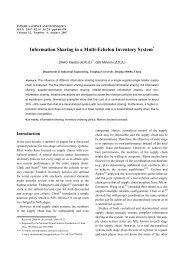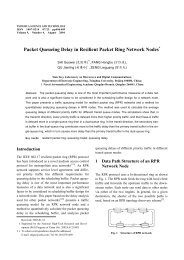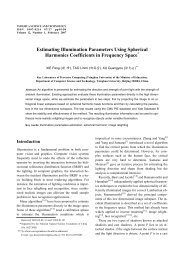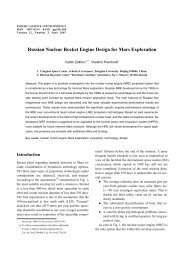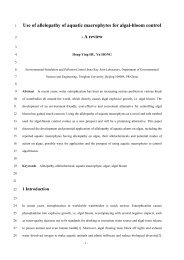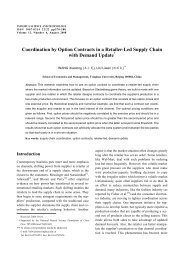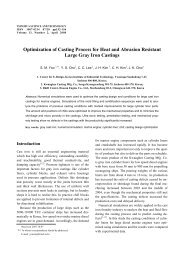Parameter Uncertainty in CGE Modeling of the Macroeconomic Impact
Parameter Uncertainty in CGE Modeling of the Macroeconomic Impact
Parameter Uncertainty in CGE Modeling of the Macroeconomic Impact
Create successful ePaper yourself
Turn your PDF publications into a flip-book with our unique Google optimized e-Paper software.
WANG Can (王 灿) et al:<strong>Parameter</strong> <strong>Uncerta<strong>in</strong>ty</strong> <strong>in</strong> <strong>CGE</strong> Model<strong>in</strong>g <strong>of</strong>… 619<br />
As with most <strong>CGE</strong> models, <strong>the</strong> substitution elasticities<br />
and <strong>the</strong> transformation elasticities are <strong>in</strong>corporated<br />
through constant elasticity <strong>of</strong> substitution (CES)<br />
and constant elasticity <strong>of</strong> transformation (CET) functions<br />
<strong>in</strong>to <strong>the</strong> production and import/export decisionmak<strong>in</strong>g<br />
procedure <strong>in</strong> TED<strong>CGE</strong>. Both <strong>the</strong>se functions<br />
have <strong>the</strong> same general form:<br />
( ( ) ) 1<br />
ρ<br />
−<br />
1 1<br />
2<br />
ρ<br />
Y = φ δ ⋅ X + −δ ⋅ X ρ (3)<br />
where Y is <strong>the</strong> aggregate composite <strong>of</strong> X1 and X2, φ is<br />
<strong>the</strong> efficiency parameter, δ is <strong>the</strong> share parameter, and<br />
ρ is <strong>the</strong> substitution parameter. The substitution parameter<br />
is a function <strong>of</strong> <strong>the</strong> substitution or transformation<br />
elasticity, ε, def<strong>in</strong>ed as ρ = ( ε −1) ε if Eq. (3) is a<br />
CES and as ρ = ( ε + 1) ε if Eq. (3) is a CET. The full<br />
model <strong>in</strong>cludes, as exogenous parameters, four substitution<br />
elasticities (three <strong>in</strong> <strong>the</strong> production function and<br />
one <strong>in</strong> <strong>the</strong> import demand function) and one transformation<br />
elasticity (<strong>in</strong> <strong>the</strong> export supply function) for<br />
each <strong>of</strong> <strong>the</strong> ten sectors, for a total <strong>of</strong> 50 elasticities to<br />
be def<strong>in</strong>ed <strong>in</strong> <strong>the</strong> calibration process.<br />
2 <strong>Uncerta<strong>in</strong>ty</strong> Analysis Method<br />
Monte Carlo simulations and unconditional systematic<br />
sensitivity analysis were used to determ<strong>in</strong>e <strong>the</strong> uncerta<strong>in</strong>ty<br />
<strong>in</strong> <strong>the</strong> <strong>CGE</strong> model results given <strong>the</strong> parameter<br />
uncerta<strong>in</strong>ty and to determ<strong>in</strong>e <strong>the</strong> importance <strong>of</strong> each<br />
<strong>in</strong>dividual parameter with respect to <strong>the</strong> uncerta<strong>in</strong>ty <strong>in</strong><br />
<strong>the</strong> outputs. These questions are answered through<br />
quantification <strong>of</strong> <strong>the</strong> uncerta<strong>in</strong>ty <strong>in</strong> <strong>the</strong> screened parameters<br />
<strong>in</strong> <strong>the</strong> form <strong>of</strong> prior probability distributions,<br />
based on random parameter values and repeated model<br />
simulations. Given a large number <strong>of</strong> simulations, <strong>the</strong><br />
probability distributions <strong>of</strong> <strong>the</strong> outcomes can be constructed<br />
as a histogram <strong>of</strong> <strong>the</strong> outcomes that approximate<br />
with arbitrarily small error <strong>the</strong> “true” probability<br />
density function <strong>of</strong> <strong>the</strong> model outcomes.<br />
S<strong>in</strong>ce all <strong>of</strong> <strong>the</strong> uncerta<strong>in</strong> elasticities <strong>in</strong> question are<br />
<strong>the</strong>oretically constra<strong>in</strong>ed to be at least non-negative<br />
and non-<strong>in</strong>f<strong>in</strong>ite, <strong>the</strong> beta family <strong>of</strong> distributions was<br />
chosen for its f<strong>in</strong>ite end-po<strong>in</strong>ts and its flexibility <strong>in</strong> represent<strong>in</strong>g<br />
different distribution shapes. A standard beta<br />
distribution, which is def<strong>in</strong>ed over <strong>the</strong> <strong>in</strong>terval (0, 1),<br />
can be transformed to any desired scale through a simple<br />
l<strong>in</strong>ear transformation. The beta distribution function<br />
has two parameters a and b and is def<strong>in</strong>ed as<br />
⎧ Γ ( a+ b) a−1 b−1<br />
⎪ x (1 − x) , 0 < x<<br />
1;<br />
f( x/ a, b)<br />
= ⎨Γ( a) Γ(<br />
b)<br />
⎪⎩ 0, o t h erwise<br />
(4)<br />
Different values for <strong>the</strong> two parameters a and b will<br />
def<strong>in</strong>e various shapes and variances <strong>of</strong> <strong>the</strong> distribution.<br />
For example, a and b are greater than or equal to 1 for<br />
symmetric and unimodal beta distributions. The population<br />
parameters <strong>of</strong> each elasticity’s distribution (e.g.,<br />
<strong>the</strong> m<strong>in</strong>imum and maximum end-po<strong>in</strong>ts) are chosen on<br />
<strong>the</strong> basis <strong>of</strong> empirical studies. The next section presents<br />
detailed <strong>in</strong>formation describ<strong>in</strong>g uncerta<strong>in</strong> elasticities<br />
exam<strong>in</strong>ed <strong>in</strong> this paper.<br />
Once <strong>the</strong> ranges and distributions <strong>of</strong> elasticities have<br />
been established, <strong>the</strong> next step is to determ<strong>in</strong>e an adequate<br />
sampl<strong>in</strong>g <strong>in</strong>tensity for <strong>the</strong> Monte Carlo experiment.<br />
The sampl<strong>in</strong>g <strong>in</strong>tensity is chosen to limit <strong>the</strong><br />
marg<strong>in</strong>s <strong>of</strong> error <strong>in</strong> <strong>the</strong> estimated means and variances<br />
<strong>of</strong> <strong>the</strong> model’s output variables <strong>of</strong> <strong>in</strong>terest to a prespecified<br />
level, chosen to be 1% <strong>in</strong> this paper.<br />
This approach quantifies <strong>the</strong> variations <strong>in</strong> <strong>the</strong> model<br />
response, but <strong>the</strong> procedure cannot identify <strong>the</strong> driv<strong>in</strong>g<br />
uncerta<strong>in</strong>ties, which are <strong>the</strong> uncerta<strong>in</strong> parameters that<br />
cause <strong>the</strong> most variance <strong>in</strong> <strong>the</strong> outputs <strong>of</strong> <strong>in</strong>terest. An<br />
unconditional sensitivity analysis, which focuses on<br />
<strong>the</strong> output uncerta<strong>in</strong>ty over <strong>the</strong> entire range <strong>of</strong> values<br />
<strong>of</strong> <strong>the</strong> <strong>in</strong>put parameters, is <strong>the</strong> preferable procedure for<br />
identify<strong>in</strong>g <strong>the</strong> driv<strong>in</strong>g uncerta<strong>in</strong>ties. The unconditional<br />
sensitivity analysis method was described by Saltelli et<br />
al. [16] In this study, <strong>the</strong> 50 elasticities <strong>of</strong> substitution are<br />
treated as uncerta<strong>in</strong> and allowed to take random values<br />
from <strong>the</strong>ir probability density functions. For each perturbation<br />
<strong>of</strong> <strong>the</strong> elasticities, <strong>the</strong> TED<strong>CGE</strong> model is recalibrated<br />
and <strong>the</strong>n solved for <strong>the</strong> benchmark and<br />
counterfactual equilibria. The actual data generat<strong>in</strong>g<br />
procedure for <strong>the</strong> calibration data set could be described<br />
as follows:<br />
For i = 1, 50 (50 elasticity parameters)<br />
Def<strong>in</strong>e s i po<strong>in</strong>ts that are <strong>the</strong> mean values <strong>of</strong> s i non-<br />
overlapp<strong>in</strong>g <strong>in</strong>tervals <strong>of</strong> equal probability, which are exhaus-<br />
tively divided <strong>in</strong> <strong>the</strong> sampl<strong>in</strong>g space <strong>of</strong> parameter i<br />
For j = 1, s i (fixed s i po<strong>in</strong>ts <strong>of</strong> parameter i)<br />
For n = 1, K (sampl<strong>in</strong>g <strong>in</strong>tensity)<br />
Select a random value from <strong>the</strong> beta distribution for<br />
each <strong>of</strong> <strong>the</strong> 49 elasticity parameters besides parame-<br />
ter i<br />
Calibrate <strong>the</strong> model based on <strong>the</strong> 50 parameters



